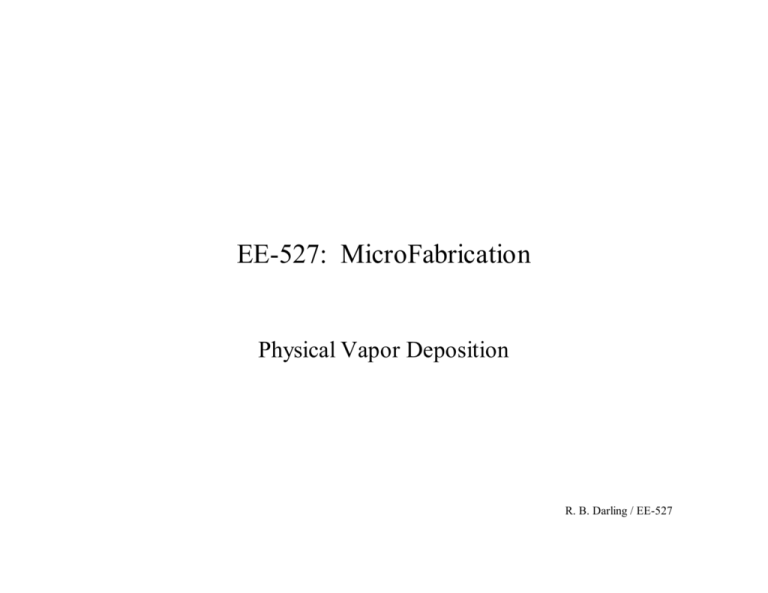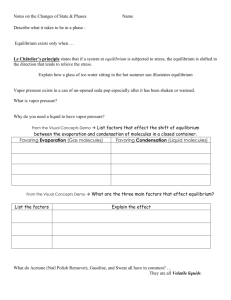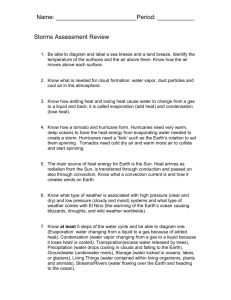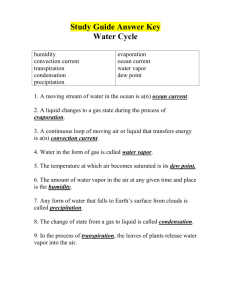EE-527: MicroFabrication
advertisement

EE-527: MicroFabrication
Physical Vapor Deposition
R. B. Darling / EE-527
Physical Vapor Deposition
Gas Phase
Gas Phase
Transport
Evaporation
Condensed Phase
(solid or liquid)
Condensation
Condensed Phase
(usually solid)
R. B. Darling / EE-527
Equilibrium Vapor Pressure
• P* is the partial pressure of a gas in equilibrium with its
condensed phase at a given temperature T.
– No net transfer of material from one state to the other.
• For a given material, P* is only a function of T.
– But the dependence of P* on T is rather complicated.
R. B. Darling / EE-527
Evaporation Rates - 1
• P* is the equilibrium vapor pressure of the evaporant at T.
• P is the ambient hydrostatic pressure acting upon the
evaporant in the condensed phase.
• Heinrich Hertz found experimentally that the evaporation
rate was proportional to (P* - P).
– This is consistent with kinetic theory in which the impingement
rates are proportional to pressure.
– Hertz also found that the evaporation rate could not be increased
by supplying more heat unless the equilibrium vapor pressure was
also increased by this action.
– Thus, there is a maximum evaporation rate set by P*, and this is
only achieved in a vacuum, where P = 0.
R. B. Darling / EE-527
Evaporation Rates - 2
• This can be viewed as two opposing fluxes:
evaporant vapor
rate goes as P
rate goes as P*
The net evaporation flux is the difference
between the impingement rates for the
two fluxes:
(
dN e
− 1/ 2
= ( 2πmk BT ) P * − P
Ae dt
)
condensed evaporant
R. B. Darling / EE-527
Evaporation Rates - 3
• Hertz only measured rates of about 1/10 of the above using
Hg vapor.
• Knudsen postulated that the evaporant vapor molecules
impinging upon the condensed phase surface may be
reflected back.
– α v = sticking coefficient for vapor molecules onto the surface.
– Then a (1 - α v) fraction of the vapor molecules contribute to the
evaporant pressure, but not to the evaporant flux.
– Therefore, the vapor pressure must be higher by a factor of 1/α v to
obtain the same evaporation rate.
• This gives the general Hertz-Knudsen equation:
dN e
− 1/ 2
= α v ( 2πmk BT ) ( P * − P )
Ae dt
R. B. Darling / EE-527
Mass Evaporation Rates
• Γ = mass evaporation rate in g/cm2-sec:
1/ 2
m
dN e
Γ=m
= α v
Ae dt
2πk BT
(P
*
− P
)
• For most elements, Γ ~ 10-4 g/cm2-sec at P* = 10-2 torr.
• The mass of the evaporated material is
Me =
t Ae
∫∫Γ dA dt
e
0 0
R. B. Darling / EE-527
Free Evaporation Versus Effusion
• Evaporation from a free surface is termed Langmuir
evaporation.
• Because α v is often much less than unity, the general
Hertz-Knudsen expression must be used.
• Effusion refers to evaporation through an orifice by which
the area of the orifice appears as an evaporation source of
the same area.
• Free evaporation is isotropic.
• Effusion is somewhat directional.
– Ideally, it is a Lambertian angular distribution.
R. B. Darling / EE-527
Knudsen Cell
• In 1909 Knudsen invented a technique to force α v to 1.
• This is called a Knudsen cell, effusion cell, or “K-” cell.
• The orifice acts like an evaporating surface of area Ae at P*,
but it cannot reflect incident vapor molecules, so α v = 1.
Isothermal enclosure with a small orifice of area Ae.
Surface area of the evaporant inside the enclosure
is large compared to the area of the orifice.
An equilibrium vapor pressure P* is maintained
inside the enclosure.
Effusion from a Knudsen cell is therefore:
(
dN e
− 1/ 2
= Ae ( 2πmk BT )
P* − P
dt
)
R. B. Darling / EE-527
Directional Dependence of a Knudsen Cell - 1
• First find the evaporant flux into a solid angle of dω from a
source area of dAe:
– In a time dt, molecules that are within vdt of the orifice will exit.
– If molecules are uniformly distributed within the volume V, then
the fraction of molecules which are within striking distance in dt of
the orifice with an exit angle of ϕ is vdt cos ϕ dAe/V.
– The fraction of molecules entering the solid angle dω is dω /4π.
The number of molecules emitted from an area dAe
ϕ
dω
of the source in a time dt into a solid angle of dω
about an exit angle of ϕ with velocities in the range
of v to v + dv is:
vdt
dAe
volume V
d 4 Ne = N
v dt cos ϕ dAe dω
Φ (v 2 ) dv
V
4π
R. B. Darling / EE-527
Directional Dependence of a Knudsen Cell - 2
• Integrate over all velocities:
– A Maxwellian distribution:
m
2
Φ (v ) = 4π
2πk BT
∞
3/ 2
2
mv
2
v exp −
2 k BT
1/ 2
1/ 2
4 2 k BT
Φ
=
(
)
v
v
dv
∫0
π m
2
=
8k BT
4
vm =
π
πm
• Obtain:
1/ 2
N 8k B T
d N e =
V πm
3
dω
cos ϕ dt dAe
4π
R. B. Darling / EE-527
Directional Dependence of a Knudsen Cell - 3
• Since PV = NkBT, the impingement rate out through the
orifice into a solid angle of dω about an exit angle of ϕ is:
1/ 2
d Ne
N 8k B T
=
dAe dt V π m
3
dω
dω
− 1/ 2
cos ϕ
= ( 2πmk BT ) P cos ϕ
4π
π
• The total impingement rate out through the orifice into all
forward solid angles is:
d 2 Ne
− 1/ 2
= ( 2πmk BT ) P
dAe dt
Note that:
∫cos ϕ
dω =
2ππ / 2
∫ ∫cos ϕ sin ϕ
0 0
dϕ dθ = π
R. B. Darling / EE-527
Directional Dependence of a Knudsen Cell - 4
• The mass evaporation rate through the orifice is
1/ 2
d 2 Ne m
P
Γ=m
=
dAe dt 2π k BT
• The mass flux into a solid angle of dω about an exit angle
of ϕ is thus
dω
3
3
d M e = m d N e = Γ cos ϕ
π
dAe dt
t Ae
M e = ∫∫Γ dAe dt
• The total mass of evaporated material is
0 0
• Cosine law of emission: (Effusion; Lambertian in optics)
dM e = M e cos ϕ
dω
π
• Normalized angular distribution function:
f (ϕ ,θ ) =
1
cos ϕ sin ϕ dϕ dθ
π
R. B. Darling / EE-527
Directional Dependence of Condensation
• The area upon which the evaporant is condensed is
r 2 dω
dAc =
cosψ
• The deposited evaporant mass per unit area of
condensation surface is thus:
dAc
ϕ
r
dM c M e
=
cos ϕ cosψ
2
dAc π r
ψ
K-cell
R. B. Darling / EE-527
Application of the Cosine Law - 1
• The cosine law was verified by Knudsen by depositing a
perfectly uniform coating inside a spherical glass jar:
cos ϕ = cosψ =
ψ
ro
r
ϕ
K-cell
r
2ro
dM c
Me
=
= uniform coating!
2
dAc
4π ro
This geometry is commercially used for coating
the inside surfaces of spherical vessels, e.g. light
bulbs, as well as for planetary wafer tooling in
vacuum coating equipment.
R. B. Darling / EE-527
Application of the Cosine Law - 2
• Uniformity of an evaporated film across a wafer:
dM c M e
substrate wafer
=
cos ϕ cosψ
2
dAc π r
r
w
ψ
reduction factor for edge thickness:
ro
re
ϕ
K-cell
d edge
d center
2
ro2
ro2
= 2 2 cos ϕ cosψ = 2 2 =
ro + rw
ro + rw
1 +
1
rw
ro
2
2
Example:
For a 3-inch diameter wafer suspended 18 inches above a Knudsen cell:
dedge/dcenter = 0.986, or a non-uniformity of 1.4 %
R. B. Darling / EE-527
Directional Dependence of a Free Point Source
• The evaporated mass from a point source is isotropic:
dω
dω
dM e = M e
4π
4π
• For a condensation surface of dAc = r2dω /cosψ , obtain:
d 3 M e = Γ dAe dt
dM c
Me
=
cosψ
2
dAc
4π r
• To put a uniform coating inside a spherical surface, a point
source must be located at the center of the sphere.
R. B. Darling / EE-527
Thermodynamic Potentials - 1
• U = U(S,V,N1,N2,… ,Nr) is the internal energy of a system
of particles.
– S = entropy
– V = volume
– N1, N2, … ,Nr are the number of particles in each of r components.
• For a monoatomic gas,
– Equation of state: PV = NRT
– Internal energy is U = 3/2 NRT
• U is a measure of the potential for work by the system.
R. B. Darling / EE-527
Thermodynamic Potentials - 2
∂U
∂S
−
= T = temperature
V , N1 ... N r
∂U
∂V
∂U
∂N j
= P = pressure
S , N1 ... N r
= µ j = electrochemical potential
S ,V , N i ≠ N j
dU = TdS − PdV + µ 1dN1 + L + µ 2 dN 2
R. B. Darling / EE-527
Thermodynamic Potentials - 3
• Helmholtz potential:
– F = F(T,V,N1,N2,… ,Nr) = U - TS
– potential for work by system at constant temperature
• Enthalpy:
– H = H(S,P,N1,N2,… ,Nr) = U + PV
– potential for work by system at constant pressure
– examples: heat engines, turbines, diesel motors
• Gibbs free energy:
– G = G(T,P,N1,N2,… ,Nr) = U - TS + PV
– potential for work by system at constant temperature and pressure
– examples: chemical reactions, electrochemistry
R. B. Darling / EE-527
Maxwell Relations
∂V
∂S
P
∂T
=
∂P
∂V
∂S
=−
∂T
∂P T
∂P
∂S
=
∂T V ∂V
∂T
∂V
S
∑
dU = TdS − PdV +
S
µ k dN k
k
∑
µ k dN k
∑
µ k dN k
dF = − SdT − PdV +
k
P
dG = − SdT + VdP +
T
∂P
=−
∂S V
dH = TdS + VdP +
∑
k
µ k dN k
k
R. B. Darling / EE-527
Mnemonic Diagram
• Originally due to Max Born:
V
F
U
S
T
G
H
P
R. B. Darling / EE-527
van der Waals Equation of State
NRT
aN 2
P=
−
V − bN V 2
– {a,b} are van der Waals parameters.
– For large volumes and small particle numbers, van der Waals
equation of state is approximated by the ideal gas law: P = NRT/V.
P
isotherms
T4
T3
T2
T1
V
R. B. Darling / EE-527
Phase Transitions - 1
– A system will only remain homogeneous if certain thermodynamic
stability criteria are met. If not, it will separate into two or more
portions.
100 % condensed phase
mixture of condensed and gas phases
100 % gas phase
P
c
g
T = constant isotherm
V
R. B. Darling / EE-527
Phase Transitions - 2
• Similarly:
T
P = constant isobar
gas
liquid
solid
V
R. B. Darling / EE-527
Phase Transitions - 3
• Internal energy = U = U(S,V,N)
– dU = TdS - PdV + µ dN, in general.
– No material is created or destroyed during a phase transition: dN = 0.
• ∆ U = Ug - Uc = T(Sg - Sc) - P(Vg - Vc)
– ∆ U = Lgc - P(Vg - Vc),
– where Lgc = T(Sg - Sc) is the latent heat of the phase transition.
• For water:
– At 0°C the latent heat of fusion is 80 cal/g = 1440 cal/mole
– At 100°C the latent heat of vaporization is 540 cal/g = 9720 cal/mole
R. B. Darling / EE-527
Equilibrium Vapor Pressure - 1
• Pressure of a gas in equilibrium with its condensed phase.
• Evaporation of the condensed phase converts thermal
energy into mechanical energy (expansion of the vapor).
• Process is less than 100 % efficient, because some thermal
energy must be used to increase the entropy of the system.
– (Second Law of Thermodynamics)
R. B. Darling / EE-527
Equilibrium Vapor Pressure - 2
100 % condensed phase
mixture of condensed and gas phases
100 % gas phase
P
P*
I
c
g
II
T = constant isotherm
V
Vc
Vg
P* is the pressure which makes areas I and II equal.
R. B. Darling / EE-527
Equilibrium Vapor Pressure - 3
• Need to integrate along the isotherm to find ∆ S = Sg - Sc.
∂S
∂S
• In general,
dS =
dV +
dT
∂V T
∂T V
• Temperature is constant during the phase change, so:
∂S
∂P
dS =
dV =
dV
∂V T
∂T V
– (Using the Maxwell relation)
• (∂P/∂T)V is independent of volume during the phase
transition, so
∂P
dP*
→
∂T
dT
• P* is a function of only T.
R. B. Darling / EE-527
Equilibrium Vapor Pressure - 4
• Integrating along the isotherm then produces
dP * ∆ S S g − S c
=
=
dT ∆ V Vg − Vc
• The latent heat of the phase transition is Lgc = T(Sg - Sc).
• Substituting gives the Clapeyron Equation:
Lgc
dP*
=
dT T (Vg − Vc )
• For low vapor pressures, Vg - Vc ≈ Vg ≈ NRT/P, which
gives the Clausius-Clapeyron Equation:
dP * Lgc dT
=
*
P
NRT 2
R. B. Darling / EE-527
Equilibrium Vapor Pressure - 5
• If Lgc is constant with temperature, integrating the
Clausius-Clapeyron equation produces an Arrhenius
relationship for the equilibrium vapor pressure:
Lgc
*
ln P = −
+ C1
NRT
Lgc
*
P = C2 exp −
NRT
• Lgc/N is tabulated for many substances, but it does have a
temperature dependence which can alter the above
integration.
R. B. Darling / EE-527
Equilibrium Vapor Pressure - 6
• The heat capacity of a material at constant pressure is:
∂H
cp =
= a + bT + cT 2 + dT − 2
∂T
– The {a,b,c,d} parameters are given in tables of thermochemical
data, e.g. the CRC Handbook of Chemistry and Physics.
• Integrating over temperature gives the temperature
dependence of the latent heat of the phase transition:
T
Lgc = Lgco +
∫(c
T0
pg
− c pc ) dT = Lgco + ∆ aT +
1
2
∆ bT +
2
1
3
∆d
∆ cT −
T
3
R. B. Darling / EE-527
Equilibrium Vapor Pressure - 7
• Integrating Lgc(T) in the Clausius-Clapeyron equation gives:
Lgco
∆a
∆ bT ∆ cT 2
∆d
*
ln P = −
+
ln T +
+
+
+ C3
2
NRT NR
2 NR 6 NR 2 NRT
– Both Lgco and C3 are unknown integration constants.
• Standard thermochemical data is specified at a “standard”
state of 1 atmosphere of pressure and a temperature of 25°C
or 298.15 K, the triple point of water.
– Need to rephrase the Clausius-Clapeyron equation to be able to use
this data.
– The standard state of temperature and pressure (STP) is usually
denoted by a “0” subscript or superscript.
R. B. Darling / EE-527
Equilibrium Vapor Pressure - 8
• Standard state chemical potentials for the gas and
condensed phases are µ go and µ co.
• Equilibrium at a given temperature occurs by letting the
chemical potentials change until they equal each other at
the equilibrium vapor pressure of P*:
P
∂µ g
∂µ c
dP = µ co (T ) + ∫
µ go (T ) + ∫
dP
∂P T
∂P T
1 atm
1 atm
• The molar volume is given as shown, and for an ideal gas,
∂µ g Vg RT
=
=
P
∂P T N
• Since Vc is small, the integral for the condensed phase can
be ignored.
R. B. Darling / EE-527
P*
*
Equilibrium Vapor Pressure - 9
• Integrating gives the standard free energy of evaporation:
∆ Geo (T ) = µ go (T ) − µ co (T ) = − RT ln P *
– P* is expressed in atmospheres.
– This now gives an expression for P* which eliminates the
unknown integration constants, but ∆ Geo is only listed for 298 K.
• Use the facts that:
∂∆ Geo
G = H − TS ,
= − ∆ S eo (T ),
∂T P
cp
∂∆ Seo
.
=
∂T P T
• Integrate twice to obtain:
T
∆ Geo (T ) = ∆ H eo (298 K ) − T∆ S eo (298 K ) −
T
∫ ∫
298 K 298 K
∆ cp
T
dTdT
R. B. Darling / EE-527
Equilibrium Vapor Pressure - 10
• A working formulation of the equilibrium vapor pressure
from standard thermochemical data is therefore:
T
T
∆ cp
∆
H
(
298
K
)
∆
S
(
298
K
)
1
*
eo
eo
ln P = −
+
+
dTdT
∫
∫
RT
R
RT 298 K 298 K T
– P* is in units of atmospheres.
– ∆ Heo(298K), ∆ Seo(298K), and cp(T) may be found in standard
tables of thermochemical data.
– Note: 1 kcal = 1 Cal = 1000 cal = 4186.8 J = 3.97 BTU
– See Section D of the CRC Handbook of Chemistry and Physics.
– Example: Aluminum:
• ∆ Heo(298K) = 70 kcal/mole, ∆ Seo(298K) = 30 kcal/mole-K, at the
boiling point of P = 1 atm and T = 2327°C = 2600 K.
• ∆ Hmo(298K) = 2.57 kcal/mole, at the melting point of P = 1 atm and T
R. B. Darling / EE-527
= 658.5°C = 931.7 K.
Equilibrium Vapor Pressure - 11
1.00E+03
1.00E+02
1.00E+01
1.00E+00
Vapor Pressure, Torr
1.00E-01 0
1000
2000
3000
4000
5000
Aluminum
Gallium
1.00E-02
Indium
1.00E-03
Silicon
1.00E-04
Gold
1.00E-05
Platinum
1.00E-06
Chromium
1.00E-07
Titanium
1.00E-08
1.00E-09
1.00E-10
1.00E-11
Temperature, K
R. B. Darling / EE-527
Equilibrium Vapor Pressure - 12
1.00E+03
1.00E+02
1.00E+01
1.00E+00
Vapor Pressure, Torr
1.00E-01 0
5
10
15
20
Aluminum
Gallium
1.00E-02
Indium
1.00E-03
Silicon
1.00E-04
Gold
1.00E-05
Platinum
1.00E-06
Chromium
1.00E-07
Titanium
1.00E-08
1.00E-09
1.00E-10
1.00E-11
Reciprocal Temperature, 10000/T(K)
R. B. Darling / EE-527
Evaporation System Requirements
• Vacuum:
– Need 10-6 torr for medium quality films.
– Can be accomplished in UHV down to 10-9 torr.
• Cooling water:
– Hearth
– Thickness monitor
– Bell jar
• Mechanical shutter:
– Evaporation rate is set by temperature of source, but this cannot be
turned on and off rapidly. A mechanical shutter allows evaporant
flux to be rapidly modulated.
• Electrical power:
– Either high current or high voltage, typically 1-10 kW.R. B. Darling / EE-527
Evaporation Support Materials
• Refractory metals:
– Tungsten (W); MP = 3380°C, P* = 10-2 torr at 3230°C
– Tantalum (Ta); MP = 3000°C, P* = 10-2 torr at 3060°C
– Molybdenum (Mo); MP = 2620°C, P* = 10-2 torr at 2530°C
• Refractory ceramics:
– Graphitic Carbon (C); MP = 3700°C, P* = 10-2 torr at 2600°C
– Alumina (Al2O3); MP = 2030°C, P* = 10-2 torr at 1900°C
– Boron nitride (BN); MP = 2500°C, P* = 10-2 torr at 1600°C
• Engineering considerations:
–
–
–
–
Thermal conductivity
Thermal expansion
Electrical conductivity
Wettability and reactivity
R. B. Darling / EE-527
Resistance Heated Evaporation
•
•
•
•
•
•
•
Simple, robust, and in widespread use.
Can only achieve temperatures of about 1800°C.
Use W, Ta, or Mo filaments to heat evaporation source.
Typical filament currents are 200-300 Amperes.
Exposes substrates to visible and IR radiation.
Typical deposition rates are 1-20 Angstroms/second.
Common evaporant materials:
– Au, Ag, Al, Sn, Cr, Sb, Ge, In, Mg, Ga
– CdS, PbS, CdSe, NaCl, KCl, AgCl, MgF2, CaF2, PbCl2
R. B. Darling / EE-527
Resistance Heated Evaporation Sources
foil dimple boat
wire hairpin
alumina coated foil dimple boat
wire helix
foil trough
chromium coated tungsten rod
wire basket
alumina crucible with wire basket
alumina crucible in tantalum box
R. B. Darling / EE-527
Electron Beam Heated Evaporation - 1
•
•
•
•
•
More complex, but extremely versatile.
Can achieve temperatures in excess of 3000°C.
Use evaporation cones or crucibles in a copper hearth.
Typical emission voltage is 8-10 kV.
Exposes substrates to secondary electron radiation.
– X-rays can also be generated by high voltage electron beam.
• Typical deposition rates are 10-100 Angstroms/second.
• Common evaporant materials:
– Everything a resistance heated evaporator will accommodate, plus:
– Ni, Pt, Ir, Rh, Ti, V, Zr, W, Ta, Mo
– Al 2O3, SiO, SiO2, SnO2, TiO2, ZrO2
R. B. Darling / EE-527
Electron Beam Heated Evaporation Source
270 degree bent
electron beam
pyrolytic graphite
hearth liner
magnetic
field
evaporation cones
of material
4-pocket rotary
copper hearth
(0 V)
recirculating
cooling water
cathode
filament
(-10,000 V)
beam forming
aperture
R. B. Darling / EE-527
Electron Beam Heated Evaporation - 2
• 270° bent beam electron gun is most preferred:
–
–
–
–
Filament is out of direct exposure from evaporant flux.
Magnetic field can be used for beam focusing.
Magnetic field can be used for beam positioning.
Additional lateral magnetic field can be used produce X-Y sweep.
• Sweeping or rastering of the evaporant source is useful for:
– Allows a larger evaporant surface area for higher deposition rates.
– Allows initial charge to be “soaked” or preheated.
– Allows evaporant source to be more fully utilized.
• Multiple pocket rotary hearth is also preferred:
– Allows sequential deposition of layers with a single pump-down.
– Allows larger evaporation sources to be used.
R. B. Darling / EE-527
High Throughput Evaporation Techniques
• Box coaters are used for evaporating large substrate
materials, often up to several meters in size.
• Large amounts of source material are required, but cannot
be all heated at once because of realistic power limitations.
• Two popular techniques:
– Powder trickler source
– Wire feed source
• Both can be adapted for either resistance heated or electron
beam heated evaporation systems.
R. B. Darling / EE-527
Adsorption
• Adsorption is the sticking of a particle to a surface.
• Physisorption:
– The impinging molecule loses kinetic (thermal) energy within
some residence time, and the lower energy of the molecule does
not allow it to overcome the threshold that is needed to escape.
• Chemisorption:
– The impinging molecule loses its kinetic energy to a chemical
reaction which forms a chemical bond between it and other
substrate atoms.
R. B. Darling / EE-527
Condensation of Evaporant - 1
• Condensation of a vapor to a solid or liquid occurs when
the partial pressure of the vapor exceeds the equilibrium
vapor pressure of the condensed phase at this temperature.
• The vapor is “supersaturated” under these conditions.
• This is only true if condensation takes place onto material
which is of the same composition as the vapor.
• When a material is first deposited onto a substrate of a
different composition, a third adsorbed phase must be
included to describe the process.
R. B. Darling / EE-527
Condensation of Evaporant - 2
• Molecules impinging upon a surface may:
– Adsorb and permanently stick where they land (rare!).
– Adsorb and permanently stick after diffusing around on the surface
to find an appropriate site.
• This can lead to physisorption or chemisorption.
– Adsorb and then desorb after some residence time τ a.
– Immediately reflect off of the surface.
• Incident vapor molecules normally have a kinetic energy
much higher than kBT of the substrate surface.
• Whether an atom or molecule will stick depends upon how
well it can equilibrate with the substrate surface,
decreasing its energy to the point where it will not
subsequently desorb.
R. B. Darling / EE-527
Condensation of Evaporant - 3
• Thermal accomodation coefficient:
Ev − Er Tv − Tr
αT =
=
Ev − Es Tv − Ts
– Ev, Tv = energy, temperature of impinging vapor molecules.
– Er, Tr = energy, temperature of resident vapor molecules;
• (Those which have adsorbed, but have not permanently found a site.)
– Es, Ts = energy, temperature of substrate surface.
• If α T < 1, (Er > Es), then some fraction of the impinging
molecules will desorb from the surface.
R. B. Darling / EE-527
Condensation of Evaporant - 4
• Mean residence time for an adsorbed molecule:
∆ Gdes
1
τa =
exp
υ0
k BT
– υ 0 = kBT/h = vibrational frequency of adsorbed molecule (~1014 Hz)
• This is the frequency at which the molecule “attempts” to desorb.
– ∆ Gdes = free activation energy for desorption.
• Under a constant impinging vapor flux of R, the surface
density of the deposit is then:
∆ Gdes
R
n s = Rτ a =
exp
υ0
k BT
– R = deposition rate in molecules/cm 2-sec.
– ns = surface density of deposited molecules in cm-2.
R. B. Darling / EE-527
Condensation of Evaporant - 5
• If the impingement rate stops, then the adsorbed molecules
will all eventually desorb.
• Condensation of a permanent deposit will not occur, even
for low substrate temperatures, unless the molecules
interact.
• Within the mean residence time, surface migration occurs
and clusters form.
• Clusters have smaller surface-to-volume ratios, and
therefore desorb at a reduced rate.
• Nucleation of a permanent deposit is therefore dependent
upon clustering of the adsorbed molecules.
R. B. Darling / EE-527
Observed Growth of a Deposited Film
•
•
•
•
•
•
•
•
•
Adsorbed monomers
Subcritical embryos of various sizes
Formation of critically sized nuclei
Growth of nuclei to supercritical size and depletion of
monomers within their capture zones
Nucleation of critical clusters within non-depleted areas
Clusters touch and coalesce into new islands, exposing
fresh substrate areas
Adsorption of monomers onto fresh areas
Larger islands grow together leaving holes and channels
Channels and holes fill to form a continuous film
R. B. Darling / EE-527
Stages of Thin Film Growth
•
•
•
•
Island Stage
Coalescence Stage
Channel Stage
Continuous Film Stage
R. B. Darling / EE-527
Modes of Thin Film Growth
(1) Volmer-Weber: (island growth):
M. Volmer and A. Weber, Z. Phys. Chem. 119, p. 277 (1926).
(2) Frank-Van der Merwe: (layer growth; ideal epitaxy):
F. C. Frank and J. H. Van der Merwe, Proc. R. Soc. London, Ser. A 198, p. 205 (1949).
(3) Stranski-Krastanov: (layers + islands):
J. N. Stranski and L. Krastanov, Ber. Akad. Wiss. Wien 146, p. 797 (1938).
R. B. Darling / EE-527
Condensation Control
• Control of condensation of the evaporant is achieved
through the control of substrate temperature Ts.
• Higher substrate temperatures:
– Increase thermal energy of adsorbed molecules.
• (Shortens the residence time.)
– Increase surface diffusivity of adsorbed molecules.
– Performs annealing of deposited film.
• Substrate heaters:
– Quartz IR lamps from frontside
– Ta, W, or Mo foil heaters from backside
– Graphite impregnated cloth heaters from backside
• Too much heat will desorb the deposited film, evaporating
it away! (But this can be used for cleaning… ) R. B. Darling / EE-527






